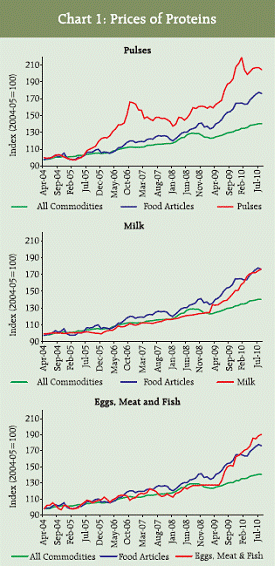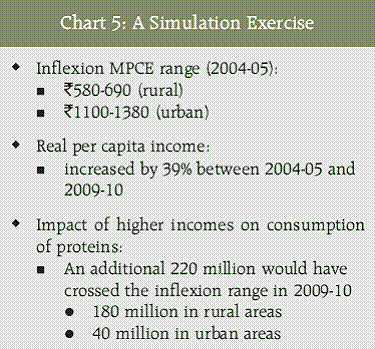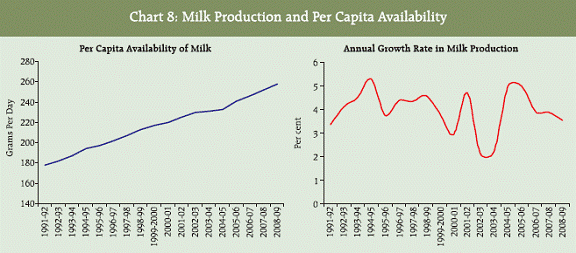The Price of Protein by Subir Gokarn - ಆರ್ಬಿಐ - Reserve Bank of India
The Price of Protein by Subir Gokarn
Introduction It is a great pleasure for me to be speaking at this seminar to celebrate the 75th birthday of Prof. Kirit Parikh. During the time that I spent at IGIDR under his leadership, I had the opportunity to work on a number of issues, on all of which I received enormous support and encouragement from him, which has continued even after first I and then he moved on to other institutions. My years at IGIDR provided me firm foundations in individual and collective research as well as teaching and dissemination, which have served me very well in the activities I have been involved in since then. I would like to thank him for his role as a mentor and belatedly wish him a happy 75th birthday. I am glad that in my current position I can contribute to shaping IGIDR’s strategies for the future. If I was asked to describe Prof. Parikh’s approach to research in one sentence, it would be: “Focus on the details, never losing sight of the big picture”. The balance between micro and macro, between individual drivers and aggregate outcomes, was visible in a lot of the research that was carried out at the institute during my time here and it is an approach that I have found most useful in applied research. Since I joined the Reserve Bank, several colleagues and I have been trying to understand the dynamics of food prices, which have been a major driver of domestic inflation over the past few years. I thought that this seminar would be an entirely appropriate occasion to present some of our analysis of the micro-level price dynamics of specific food items, based on demand-supply fundamentals and then relate this analysis to two very significant ‘big picture’ issues. The Context When we break down recent food inflation into contributions by different items, a striking feature is the role played by key sources of protein. The dominant source of protein in Indian diets is pulses, which, of course, vary quite significantly across regions and, to some extent, between income groups. Milk and milk products also figure quite prominently and then we have Eggs, Meat and Fish. Analysis of dietary patterns in terms of income elasticities suggests that as incomes increase, the share of proteins in representative diets also increases. In other words, as levels of affluence increase, the demand for proteins is bound to increase overall; the form in which they are consumed will, of course, differ based on geography and socio-cultural factors. In recent years, the shifts in income distribution and their impact on the demand for a whole range of products – two-wheelers, automobiles, consumer durables, mobile phones and so on – has been extensively analysed, which in turn has provided significant inputs into business strategy. When it comes to proteins, apart from business strategy, the impact of income growth and distribution has significant policy implications as well, which is what I mean by ‘big picture’ issues and which I shall come to later in the presentation. Price Dynamics The recent transition in the Wholesale Price Index from the 1993-94 base to the 2004-05 base highlighted the impact that a changed production/consumption basket can have on measured inflation. Specifically, food inflation as measured by the new index is noticeably higher than that measured by the old one. The primary reason for this is that the items that I have been talking about – alternative protein sources – along with some others, have higher weights in the new index, which, of course, suggests that the price of proteins has been increasing relatively faster than other food items. Charts 1 and 2 display the relative rates of increase. From Chart 1, it appears that the price levels of Pulses began accelerating in 2005 and have continued to do so since then. There is a sustained divergence between the Pulses index and the overall Food index, which suggests a structural change in relative prices. Of course, there is a wide variety of pulses consumed across the country, with strong regional patterns. But, even at an aggregate level, Pulses are clearly becoming more and more expensive and, contrary to widespread perceptions, this does not appear to have much to do with the performance of the monsoons. Milk and Eggs, Meat and Fish also show a distinct upturn in price levels, though this is of somewhat more recent origin than for Pulses. Chart 2 displays the inflation rates for these three sets of food items. The pattern for Pulses appears to conform to perceptions about sensitivity to monsoons. At least in the most recent months, the inflation rate for pulses has dropped significantly – in fact, below the overall rate of food inflation. However, the inflation rates for the other two items continue to be above the overall food inflation rate. The rate for Eggs, Meat and Fish has dropped a bit, but the rate for Milk appears to have its own dynamic.
Of course, this is not sufficient to draw any inferences about the structural nature of protein price inflation. Chart 3 presents the results of the decomposition of the three price level series. The red lines capture the structural components and the picture is unmistakable; the prices of all three protein sources are on a strong upward trajectory, which, is occasionally offset by favourable cyclical factors, particularly in the case of Pulses, given the direct impact of monsoon performance on Pulse production.
Demand Drivers The 61st Round (2004-05) of the National Sample Survey is the most recent large sample data available for consumer expenditure. Though dated, it provides a basis for analysing the relationship between household affluence and expenditure on various items. In the course of this project, we have estimated price and income elasticities for a variety of food products, including the three categories on which this presentation is focused, at several levels of disaggregation – by item, by state and by income fractile. The results will eventually be published in a detailed report, but given the occasion and time constraints, I would just like to convey a sense of what we are attempting to do. Essentially, it is the analysis of inflection points: what is the threshold level of income (or, in this case, household expenditure) at which the composition of the diet changes significantly. A national aggregate is not a very precise way of doing this, given the enormous variations in factors that drive consumer behavior across the country, but it serves to illustrate the approach. Chart 4 presents the relationship between Monthly Per Capita Expenditure (MPCE), which is of course a proxy for household affluence and the level of spending on the three protein sources that we are discussing. Interestingly, the expenditure on Milk and Milk Products is higher than that on Pulses in all expenditure fractiles of the urban population, while it begins to dominate Pulses at a fairly low fractile in the rural population. Eggs, Meat and Fish also begin to dominate Pulses, though at somewhat higher income fractiles in both rural and urban populations.
But, to focus on the main point that this analysis seeks to make, it is the points of inflection visible on the graphs that are most relevant. I would like to present a simple simulation exercise to illustrate the use of this information for making aggregate projections of demand for these items. Chart 5 presents a summary of the exercise.
Let us assume that the point of inflection on the graph reflects the expenditure level (in 2004-05 prices) at which diets shift decisively towards higher consumption of proteins. Between 2004-05 and 2009-10, per capita incomes grew by about 39 per cent. With this growth, how many people are likely to have reached this threshold by 2010? Assuming that the distribution itself remains constant, the simulation reveals that about 220 million – 180 million in rural areas and 40 million in urban areas – people would have reached the threshold level of MPCE over this five-year period. In addition to this, people who were already above the threshold in 2004-05 would, as a result of rising incomes, presumably also increase their consumption of these items. At the aggregate level, this analysis presents a dramatic picture of how increasing affluence is impacting the spending on protein sources. This pattern is in complete conformity with global historical precedents, a point to which I shall return in the discussion of ‘big picture’ issues. This is exactly the kind of dynamic that has been seen in the Indian economy for products like two-wheelers, automobiles, various consumer durables and a host of others. But, unlike in food items, the massive expansion of demand for these products was not accompanied by a sharp surge in prices. The obvious reason for this was that the supply response in these markets was strong enough to keep pace with demand. A combination of large new capacities, free trade and scale economies and technological progress has helped to increase supply even while costs have fallen. Unfortunately, the same powerful supply response is yet to manifest itself as far as proteins are concerned. Supply Conditions Let us take a brief look at the supply scenario in each of these protein sources. Chart 6 displays the per capita availability of Pulses as a whole and separately for Tur (Arhar). This is a story of long-term decline in availability, in which production has not been able to keep pace with population growth, let alone increasing affluence and, consequently, greater demand for both Pulses as a whole and Tur in particular. Heavy rain dependence, small holdings and weak rural infrastructure seem to be preventing any break-through surges in productivity in the way that massive increases in cereal production was achieved. Chart 7 shows just how volatile the supply situation in Pulses is. As regards production and yield, there is a reassuring trend towards stable growth during the past couple of years at the aggregate level. However, the disaggregated picture shows that individual Pulses are subject to relatively high production volatility, which given the relatively low degree of substitutability that is visible in Pulse consumption, inevitably contributes to price volatility. Overall, if the very recent trend in aggregate production is sustained, supply constraints will ease. Going by the past record, however, there do not appear to have been persistent phases of output growth, which indicates the difficulty of achieving a break-through.
One option is to import Pulses. Since very few other countries produce and consume significant quantities of this item (and certainly, Tur is virtually unique to India), this would have to be in the form of contract farming arrangements. While this may be feasible in terms of actual production, transportation costs are likely to neutralise any benefits from such arrangements as a way of meeting demand while keeping prices in check. Chart 8 displays the supply scenario for Milk. In terms of per capita availability, it is clearly a far more reassuring trend than for Pulses. This indicator of supply has been rising steadily, reflecting the many organisational and logistic innovations that were effectively implemented in this sector. However, two factors need to be taken into consideration here. One, the second graph on the slide indicates that the growth rate of Milk production is declining and volatile. Two, returning to the demand perspective, Milk is the most significant source of protein in expenditure terms for most households. Since it is directly related to the age composition of households, the preponderance of growing children and young adults is likely to boost demand for milk, all other factors remaining equal. With a sustained increase in demand, slowing growth and volatile production will clearly have an impact on prices.
Chart 9 provides one explanation for why the Milk supply situation may be turning adverse. Oil cake is a significant component of cattle feed and its price clearly has an impact on the cost of production of Milk. With oil cake prices trending up quite significantly over the past few years, changes in the feed mix may be resulting in lower yields, contributing to supply-demand imbalances and price pressures. The picture for Eggs, Meat and Fish is generally similar to that of Milk. For illustrative purposes, Chart 10 displays the per capita availability and growth rates for Egg production. While production and availability have been increasing, the growth rate shows relatively high volatility, raising the prospect of price surges in the face of steadily increasing demand. Of course, given the significance of the informal sector in the production and distribution of all these items, production data might reasonably be considered a bit suspect. However, the bottom line is that the price dynamics of this category of proteins are entirely consistent with an emerging structural imbalance between demand and supply.
Big Picture Issues So far, I have been dealing with the microeconomics of protein prices – the interplay between demand and supply for individual food items. I will conclude this presentation by exploring the linkages between the micro and the macro with reference to two important issues.
The first is the significance of these individual price dynamics to a basic concern of central banking. From a monetary policy perspective, the conventional view of food prices, is that surges are temporary, driven by supply disruptions that at worst last one season. As conditions return to normal, as they usually do, the price surges are expected to recede. Transmission lags in monetary policy are generally seen to be longer than the typical agricultural season, so, if monetary instruments are used to deal with such price shocks, they have no impact on the immediate cause of the problem, while possibly doing damage to growth prospects down the road. However, if the economy is at or close to full capacity utilisation, even a temporary price shock can aggravate inflationary expectations, which may justify a monetary response even though the shock is temporary and will die out before the actions take effect. But, when we begin to consider the impact of structural food price shocks, such as the ones we appear to be experiencing in the Indian context, the policy implications become complex. Do we treat these developments as a change in relative prices, with consumers substituting away from the increasingly expensive food items, with no particular macroeconomic significance and, therefore, no implications for policy? Or, do we see them as a threat to overall price stability because there are really no substitutes for protein and increasing prices of its sources will immediately translate into higher wages and, through them, to generalised inflationary pressures, which certainly warrant a policy response? Persistent price increases in commodities for which there are no effective substitutes will, other things remaining equal, raise the potential rate of inflation over a period of time. This means that either actual inflation or interest rates will be higher than they would be in the absence of such increases. The second big picture issue relates to the welfare implications of high protein prices. We are used to thinking about economic development as a process of transformation, which can be measured in terms of some universal indicators: the share of agriculture in GDP, for example, or the degree of urbanisation, all of which provide the foundations for greater affluence. But, there is also a strong nutritional dimension to development. Beyond basic food security, which may be provided even by a carbohydrate-dominated diet, economic development is closely associated with the increasing significance of protein in people’s diets, which in turn is driven by the decreasing relative prices of protein sources. India has certainly experienced phases when this has taken place – for example the surge in Milk production that was termed the White Revolution – but the analysis presented above suggests that these trends have not been sustained. Rapid economic growth is contributing to the emergence of persistent demand-supply imbalances which, in turn, are making proteins more expensive. In the absence of a significant positive supply shock, this might result in the weakening of the economy’s most productive resource – its people. Concluding Comments Increasing demand for proteins appears to be an inevitable consequence of rising affluence. The availability and affordability of proteins is, therefore, an important indicator of an equitable and sustainable development process, with implications for both nutritional balance and macroeconomic stability. To help achieve both objectives, a powerful supply response in all sources of protein is needed. The Green Revolution succeeded in doing this for carbohydrates. The White Revolution succeeded, at least for a while, in doing it for Milk. Similar combinations of factors now need to be brought to bear on the goal of ensuring protein security for the Indian economy. Once again, my best wishes to Prof. Parikh and thank you all for listening to me. * Inaugural Address by Dr. Subir Gokarn, Deputy Governor, Reserve Bank of India at Special Conference in honour of Dr. Kirit Parikh at IGIDR, Mumbai on October 26, 2010. Assistance provided by Balbir Kaur, Praggya Das, Abhiman Das, Nishita Raje, Muneesh Kapur, Rekha Misra, Deepa Raj and Atri Mukherjee is gratefully acknowledged. Data support received from Poonam Munjal of CRISIL is also gratefully acknowledged. This address draws upon the ongoing research project in the Reserve Bank on structural drivers of food inflation in India. |


































